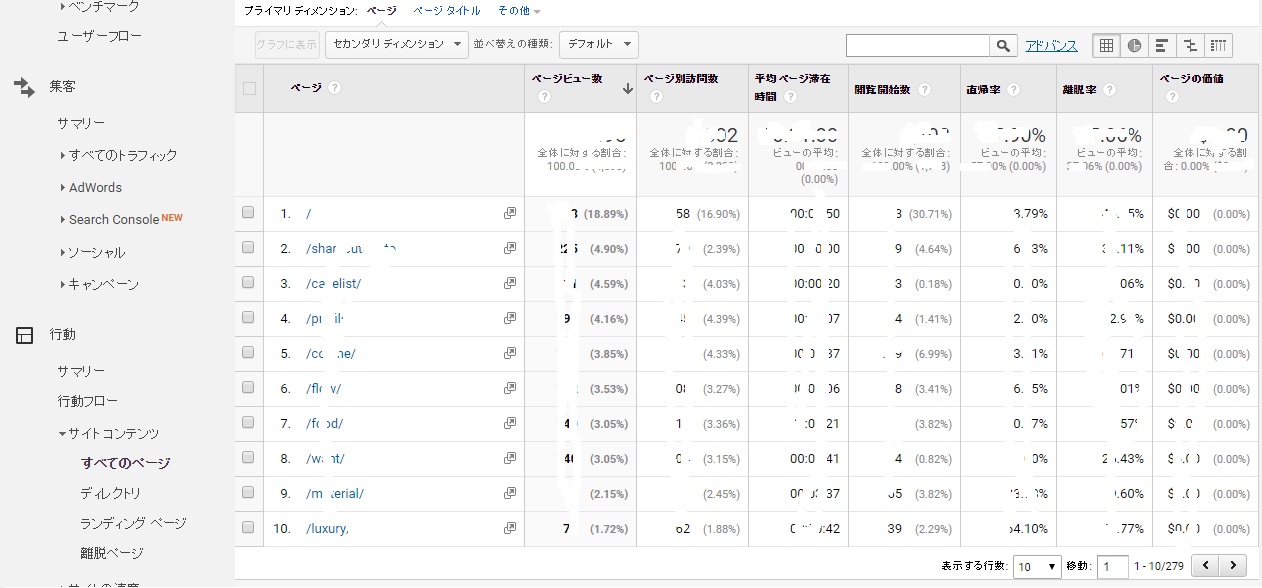アドバンスフィルタ(google analytics) | WEBマーケティング用語
アドバンスフィルタ(google analytics)
アドバンスフィルタ(google analytics)は、グーグルアナリティクスの分析画面上の機能のひとつで、アドバンスフィルタを使うと複数のフィルタを同時に使ってデータを見るなど複雑な抽出ができます。

一方、高度なセグメントは、分析のためにウェブサイトに関する詳細のサブグループを分離する素晴らしい方法です。準備が整えられたセグメントがたくさんあります。また、独自のセグメントを作成することもできます。一般的なデフォルトセクションを使用すると、直接トラフィックだけを表示したり、ウェブサイトへのトラフィックを検索したりすることができます。カスタムセクションを使用すると、モバイル機器に関連するトラフィックのみを表示するなどの操作を行うことができます。革新的なセクションは、他の情報を切り捨てて、重要なものだけを見ることができるので便利です。高度なセクションは基本的に論理式を使用してデータを除外するフィルタですが、プロファイルに適用できるフィルタとは大きく異なります。
履歴レポート:フィルタと比較して高度なセクションとの最も顕著な違いは、履歴データに適用できる可能性が高いことです。一方、高度なセグメントは、プロファイルデータに遡及的に適用されることがあります。データの比較:一度に1つ以上のセクションを選択することにより、レポートでメトリックを比較することができます。トラフィックを除外:高度なセクションよりもフィルタが有用な場所は、トラフィックを除外することです。どのような場合でも、高度なセクションでこのトラフィック情報を絶えず操作することを覚えていると痛いかもしれません。それがフィルターが便利な場所です。デフォルトオプションの洗練されたセクションを使用するには、以下の手順に従ってください。
ページの上部にある[詳細セクション]をクリックします。メニューは左側のデフォルトセクションと右側のカスタムセクションを表示します。カスタムセクションはアカウントレベルで作成されます。アカウントに家を表示している限り、アナリティクスの別のプロパティでユーザーを作成しても、そのアカウントのセクションは問題なく表示されます。データを表示するセグメントをクリックします。デフォルトのセクションと同じように動作しますが、ユーザーによって作成され、汎用性があります。
あなたのウェブページ上のカスタマイズされたコードを使用して情報をキャプチャし、その後、このコードのような洗練されたセクションでそれを使用して、個人が複数の人気のあるソーシャルネットワークアカウントにログインした訪問を奪取する必要があります。詳細セクションを作成するプロファイルをクリックします。表示されるダイアログボックスの右側で、+新しいカスタムセグメントをクリックします。次に、カスタムセグメントのガイドラインを設定する必要があります。
The advanced filter (google analytics) is one of the functions on the Google Analytics analysis screen, and if you use the advanced filter, you can extract complex data such as viewing data using multiple filters at the same time.
Advanced segments, and on the other hand, are a fantastic way of isolating subgroups of details about your web site for analysis. There are a lot of ready made segments, and you may also create your very own. Using common default sections, you can see only direct traffic or only search traffic to a website. Using custom sections, you can do things such as only see traffic related to mobile apparatus. Innovative sections are useful since you may cut out other information and only look at what’s important to you. Even though advanced sections are basically filters which use logical expressions to exclude data, they’re much different than the filters that may be applied to profiles.
Historical reports: likely the most notable differences with advanced sections compared with filters is in which you can be applied to historical data. On the other hand, advanced segments might be applied retroactively on profile data. Comparing data: By choosing one or more section at a time, you may compare the metrics together in reports. Excluding traffic: a place where filters may be more useful than advanced sections is with excluding traffic. Regardless of the case can be, remembering to constantly manipulate this traffic information with sophisticated sections may be a pain, and that’s where filters come in handy. Follow the steps below to use default option sophisticated sections.
Click Advanced Sections near the top of the page. A menu will drop down revealing default sections on the left and any custom sections on the right. Note that custom sections are created in the account level. Even when you’ve been made a user on another Analytics property, so long as you’re viewing a house in your account, the sections for that account will appear no matter if they’ll work. Click any segment that you would like to view data for. They work in the same manner that the default sections do, yet, they’re created by the user and have become versatile.
You should use customized code on your webpage to capture info and after that use it in sophisticated sections like this code to seize visits where individuals were logged into more than one popular social network accounts. Click the profile where you would like to create the advanced section. On the right hand side of the dialog box that appears, click +New Custom Segment. Next, you’ll have to set the guidelines for the custom segment.
それ以降のバージョンを使用している場合、このヒントはうまくいかないかもしれません。オートフィルタには、情報を処理する際に必要な筋肉がないというシナリオが多数あります。フィルター比較で計算を行う必要があるかもしれません。このような場合、Excelの洗練されたフィルタリング機能を使用できます。洗練されたフィルタリングでは、ワークシートに標準範囲を設定する必要があります。この標準品種は情報リストの一部ではなく、フィルタリングの実行方法を示すために使用されます。通常、あなたの情報リストの前にあなたの基準を置くでしょうが、後に置くこともできます。
重要なのは、あなたの基準をあなたと情報のリストを空の行が1つ分だけ区別できるようにすることです。それ以外の場合、Microsoft Excelは標準が実際のデータリストの一部であると考えるかもしれません。標準はワークシートに入力され、各列は代替論理AND評価を示し、すべての行は異なる論理OR比較を表します。ワークシートの6行目から始まる情報リストがあるとしましょう。上記の行を除いて、フィルタリング基準を設定しています。情報リストには、株の情報を記述する列が含まれています。
すべての在庫アイテムから得られた利益を示唆する測定列もあります。ある時点で、情報リストをフィルタリングすることができます。したがって、ストックアイテムの小さなサブセットのみが表示されます。金額が2500を超え、利益が1000未満のアイテム、または7500を超える可能性のあるアイテム、または利益が100未満のアイテムのみを表示したい場合があります。フィルターを使用すると、条件を設定するだけです。この例では、最初の行は比較に使用するフィールド名を示し、2番目から4番目の行は実際の比較を定義します。
2番目の行には2つの試行があるため、これらはANDの状況とみなされ、他の行の人はORの問題とみなされます。[データ]メニューから[フィルタ]を選択し、[詳細フィルタ]を選択します。Microsoft Excelでは、元の情報テーブルのアドレスが[List Range]ボックスに既に入力されているAdvanced Filterウィンドウボックスが表示されます。マウスを使用して要件選択、セルA1:B4を選択します。
If you’re utilizing a later version, this tip might not work for you. There are many scenarios wherein AutoFilter simply doesn’t possess the muscle you need when processing your information. You may need to do a calculation in a filter comparison. In these instances, you can use the sophisticated filtering capabilities of Excel. Sophisticated filtering requires that you put up a standards range in your worksheet. This standards variety is not part of the information list, but rather is used to indicate how you need filtering to be performed. Normally, you’d place your standards before your information list, but you could also place it after.
The important thing is that you distinguish your standards from you information list by a minumum of one empty row. Otherwise, Microsoft Excel might think that the standards are part of the real data list. The standards are entered in the worksheet such that each column presents an alternative logical AND assessment, and every row represents a distinct logical OR comparison. Let’s say you’ve an information list that starts in the 6th row of a worksheet. You have put aside the rows above this to set your filtering standards. The information list includes columns that describe info in your stock.
There is also a measured column that suggests the gain derived from every inventory item. At some point you may want to filter your information list therefore it shows only a small subset of your stock items. You may like to see only these items for which the amount is over 2500 and gain is less than one thousand, or those items where the quantity can be higher than 7500, or these items where profit is under 100. To set up this type of filter, all you should do so is set your criteria. In this instance the first row reveals the field names for use in comparisons, whilst the second through 4th rows define the actual comparisons.
Notice that since there are two trials in the second row, these are considered an AND situation, and people on the other rows are considered OR problems. Choose Filter from the Data menu, then select Advanced Filter. Microsoft Excel displays the Advanced Filter window box with the address of your original information table already filled in, in the List Range box. Use the mouse to choose the requirements selection, cells A1: B4.
